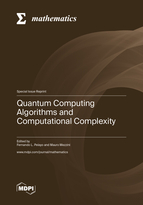Quantum Computing Algorithms and Computational Complexity
A special issue of Mathematics (ISSN 2227-7390). This special issue belongs to the section "Mathematics and Computer Science".
Deadline for manuscript submissions: closed (30 June 2022) | Viewed by 14881
Special Issue Editors
Interests: quantum computing; algorithms complexity; formal models of concurrency; discrete dynamical systems
Special Issues, Collections and Topics in MDPI journals
Interests: neural networks; graph and hypergraph algorithms; quantum algorithms
Special Issues, Collections and Topics in MDPI journals
Special Issue Information
Dear Colleagues,
In his paper in 1982, Richard Feynman stated that in order to simulate quantum systems we would rather go for a sort of brand-new powered quantum processor instead of a classical computer. Ever since then, Quantum Computation has been growing in terms of both the architectural issues associated with such quantum computers and the algorithms that can be run over them and has attracted much interest from the computer science community.
The intrinsic parallelism that comes with the superposition of quantum states provides us with a key advantage when facing heavy computational problems, such as encrypting/decrypting tasks, or studying quantum issues of matter.
Quantum Computing is a hot research field at the intersection of mathematics, computer science, and physics. This Special Issue is mainly concerned with quantum algorithms, the mathematics underlying them, and complexity issues arising from them.
Dr. Fernando L. Pelayo
Dr. Mauro Mezzini
Guest Editors
Manuscript Submission Information
Manuscripts should be submitted online at www.mdpi.com by registering and logging in to this website. Once you are registered, click here to go to the submission form. Manuscripts can be submitted until the deadline. All submissions that pass pre-check are peer-reviewed. Accepted papers will be published continuously in the journal (as soon as accepted) and will be listed together on the special issue website. Research articles, review articles as well as short communications are invited. For planned papers, a title and short abstract (about 100 words) can be sent to the Editorial Office for announcement on this website.
Submitted manuscripts should not have been published previously, nor be under consideration for publication elsewhere (except conference proceedings papers). All manuscripts are thoroughly refereed through a single-blind peer-review process. A guide for authors and other relevant information for submission of manuscripts is available on the Instructions for Authors page. Mathematics is an international peer-reviewed open access semimonthly journal published by MDPI.
Please visit the Instructions for Authors page before submitting a manuscript. The Article Processing Charge (APC) for publication in this open access journal is 2600 CHF (Swiss Francs). Submitted papers should be well formatted and use good English. Authors may use MDPI's English editing service prior to publication or during author revisions.
Keywords
- quantum algorithms
- quantum computing
- computational complexity
- quantum simulation







